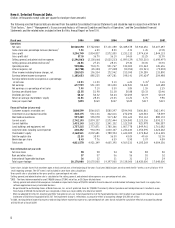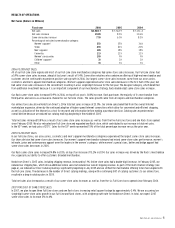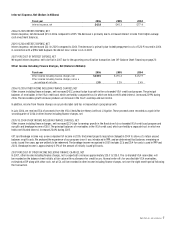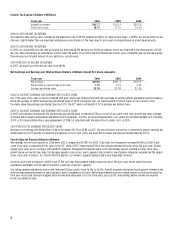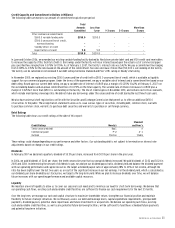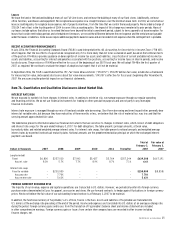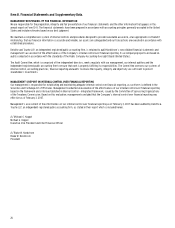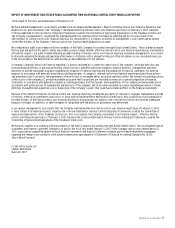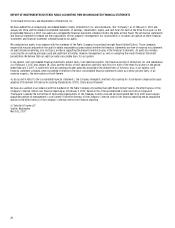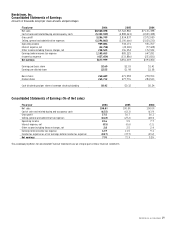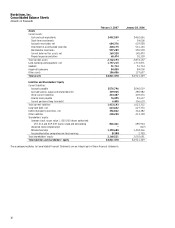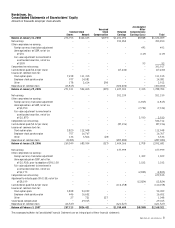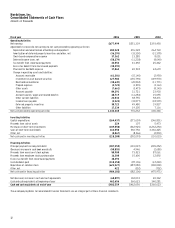Nordstrom 2006 Annual Report Download - page 40
Download and view the complete annual report
Please find page 40 of the 2006 Nordstrom annual report below. You can navigate through the pages in the report by either clicking on the pages listed below, or by using the keyword search tool below to find specific information within the annual report.
22
In the first quarter, the VISA Trust requires that cash receipts be used to establish a pre-funding account to repay the 2002 A&B Notes;
this pre-funding balance reduces the overall yield in the VISA Trust, which is expected to reduce our earnings by $7.0.
After we combine the securitization programs in April 2007, our investment in the VISA Trust will be reclassified from available-for-sale securities to
receivables, at fair value with no allowance for credit losses. Based on past payment patterns, these receivables will be repaid within eight months.
During that time, we expect to record incremental bad debt write-offs and certain finance charge income as an adjustment to the fair value of the
receivables acquired, reducing the yield of these receivables; these costs are expected to be $16.0 and will be recorded over the eight month
repayment period. Following the recognition of the $7.0 yield reduction in the first quarter and the $16.0 of other adjustments through the remainder of
2007, the private label charge card receivables and the co-branded VISA credit card receivables will be recorded at historical cost, net of bad debt
allowances, on our balance sheet.
As card holders continue to use their co-branded VISA credit cards, new receivables will be recorded. Those new receivables will be recorded at
historical cost; as those receivables age, we will establish an allowance for bad debts based on historical write-off experience. We expect to record
$25.0 to $35.0 of bad debt provision in selling, general and administrative expenses from these new receivables. The classification of this expense is
different because these receivables are ‘on-balance sheet;’ in the past, the write-off experience was considered in our investment yield and reflected
in other income including finance charges, net. We do not expect the co-branded VISA credit card receivable write-off experience to be impacted by
the transition in the accounting treatment, only the classification of this expense will change.
As noted above, all debt issued by the combined trust will be recorded on our balance sheet, so the related interest expense will be recorded in
interest expense, net. Currently, the interest expense of the debt issued by the VISA Trust reduces our overall yield from our investment and is
recognized in other income including finance charges, net.
With the bad debt and interest expense impacts shifting out of other income including finance charges, net, we expect our other income line item on
our earnings statement to increase by $45.0 to $55.0.
We expect our earnings before income tax expense to be reduced by $23.0, or $0.05 per diluted share, for the transition from fair value to historical
cost. The other earnings statement classification changes associated with the accounting treatment for the combined securitization program are not
expected to impact our earnings before income tax expense. In the future, our ROIC rate will be reduced because we will recognize additional invested
capital from the securitization program transition.
Interest Rate Swaps (Dollars in Millions)
To manage our interest rate risk, we entered into an interest rate swap agreement in 2003, which had a $250.0 notional amount expiring in January
2009. Under the agreement, we receive a fixed rate of 5.63% and pay a variable rate based on LIBOR plus a margin of 2.3% set at six-month intervals
(7.70% at February 3, 2007). The interest rate swap agreement had a fair value of $(8.9) and $(11.1) at the end of 2006 and 2005.
Contractual Obligations (Dollars in Millions)
The following table summarizes our contractual obligations and the expected effect on our liquidity and cash flows as of February 3, 2007. We expect
to fund these commitments primarily with operating cash flows generated in the normal course of business and credit available to us under existing
and potential future facilities.
Total
Less than
1 year
1–3 years
3–5 years
More than
5 years
Long-term debt
$630.9
$5.9
$262.3
$9.9
$352.8
Capital lease obligations
13.5
1.9
3.3
2.4
5.9
Other long-term liabilities
222.3
30.8
40.3
20.2
131.0
Operating leases
650.2
78.0
148.1
130.5
293.6
Purchase obligations
1,070.0
1,056.1
12.7
1.0
0.2
Total
$2,586.9
$1,172.7
$466.7
$164.0
$783.5
In addition to the required debt repayments disclosed above, we estimate total interest payments of approximately $512.6 as of February 3, 2007,
payable over the remaining life of the debts.
Other long-term liabilities consist of workers’ compensation and general liability insurance reserves and postretirement benefits. The repayment
amounts presented above were determined based on historical payment trends. Other long-term liabilities not requiring cash payments, such as
deferred property incentives, were excluded from the table above.
Purchase obligations primarily consist of purchase orders for unreceived goods or services and capital expenditure commitments.
This table also excludes the short-term liabilities, other than the current portion of long-term debt, disclosed on our 2006 balance sheet, as the
amounts recorded for these items will be paid in the next year.
Long-term debt excludes debt issued by the VISA Trust, including $200.0 off-balance sheet receivable backed securities due in April 2007 and $350.0
variable funding note that can be renewed in August 2007.


